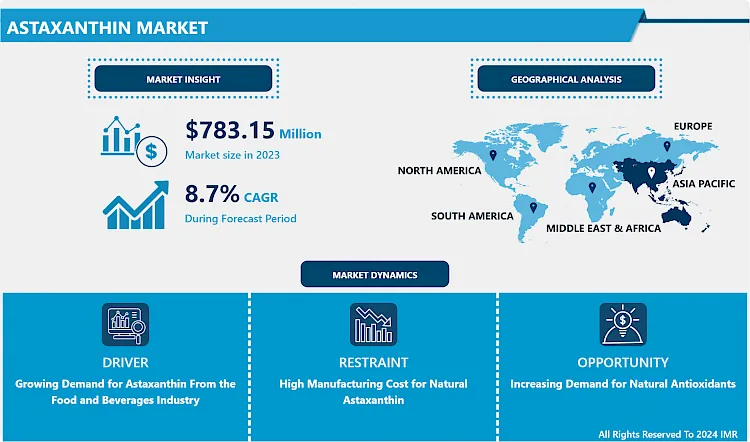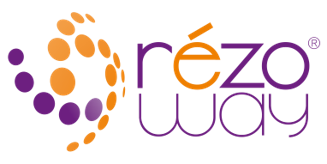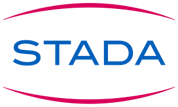Astaxanthin Market Overview
The Global Astaxanthin Market was estimated at USD 783.15 Million in 2023, and is anticipated to reach USD 1659.25 Million by 2032, growing at a CAGR of 8.7% over the analysis period 2024-2032.
- Astaxanthin refers to that a reddish-brown pigment, belonging to a group of chemicals known as the xanthophyll category of carotenoids. It generally occurs naturally in some algae and lends the red or pink color in trout, salmon, shrimps, lobsters, and other seafood. A short while ago, yeast/fungi-based and synthetic astaxanthin have also received remarkably fame. Moreover, Astaxanthin stability was evaluated in different carriers and storage environments. Astaxanthin was obtained from Haematococcus and its stability in different edible oils was governed. Astaxanthin was immovable or secure at 70–90 °C in rice bran, gingelly, and palm oils with 84%–90% of retention of astaxanthin content which can be utilized in food and beverages, aquaculture and animal feed, pharmaceutical and nutraceutical applications, whereas astaxanthin content was brought down at 120 and 150 °C. Furthermore, astaxanthin is generally consumed orally and helps cure various chronic ailments. It has been highly employed to treat Alzheimer's disease, Parkinson's disease, liver malfunctions, high cholesterol, and macular degeneration. Numerous astaxanthin drugs have immense the market in recent years. Apart from this astaxanthin has also been widely utilized to treat heart diseases, strokes, and male infertility.
- In addition, it protects the skin against sunburn and overcomes wrinkles. The application of astaxanthin products in dietary supplements is due to their easy availability coupled with cardiovascular benefits. Also, the product is inspected to be over 500 times healthier than vitamin E and is much more beneficial than other carotenoids such as lutein and lycopene. Such various applications are probably boosting the astaxanthin market during the forecast period.

Market Dynamics And Factors For Astaxanthin Market
Drivers:
- The growing demand for astaxanthin from the food and beverages industry is increasingly being used as a food-coloring ingredient, an antioxidant to maintain the taste, color, freshness, and quality of food products. Traditionally, astaxanthin was mostly used to maintain the nutrients of the food from damage, improve sensory aspects, and boosting the overall appeal of food products. In the region of Europe, astaxanthin has received acceptance as an essential raw material to produce dietary nutrition.
- The aquaculture and animal feed sector are majorly dependent on feed additives for rich nutritive benefits for animals. Astaxanthin is used to increase nutritional value and pigmentation in animal feed. Hence, the development of poultry and aquaculture businesses has turned the market for astaxanthin since the increased usages of animal feed for health concerns. The remarkable growth in fisheries and aquaculture production has resulted in the raised consumption of different nutritious food products. Growing global consumption of seafood due to the increasing consumer consciousness about the health benefits of consuming fish and other aquaculture species.
- Key players working in the astaxanthin market landscape are also anticipated to introduce the latest and eco-friendly bio-astaxanthin to acquire an edge over competitors. Many key players are anticipated to invest in R&D for new astaxanthin that is anticipated to find utilizations in the aquaculture space. For example, in December 2019, Japanese scientists disclosed that they have found a novel way to synthesize natural astaxanthin by using marine algae.
Restraints:
High Manufacturing Cost For Natural Astaxanthin
- Astaxanthin can be incorporated naturally as well as synthetically. Synthetic astaxanthin is produced by various chemical formulations from petrochemicals products and is available at comparatively lower rates in the market. Additionally, natural astaxanthin is made through fermentation and extraction methods involving several microorganisms such as bacteria, fungi, yeast, marine animals, and algae. This natural astaxanthin is comparatively tough to manufacture and is costlier than synthetic astaxanthin.
Opportunities:
Increasing Demand For Natural Antioxidants
- There is a rising demand for natural carotenoids in their pure with compared to synthetic carotenoids, especially in the dietary supplements industry, owing to their high effectiveness and quality. The current process used for natural means of manufacture of carotenoids is limited and subject to contamination. These processes are costly, and hence, the costs of natural carotenoids such as beta-carotene and lycopene are almost three times higher than those of synthetic carotenoids.
Challenges:
Strict Government Policies In Developed Economies
- The regulatory issues for application areas of astaxanthin are witnessed to be different in all regions. FDA controls nutraceuticals under different norms and regulations in the United States. According to the Dietary Supplement Health and Education Act, 1994 (DSHEA), the producer must ensure that a nutraceutical-based product or ingredient is safe before it is a sale. Furthermore, the FDA is sanctioned to take action against any harmful product only after it reaches the market. Thus, producers are required to make sure the product label and be transparent about information.
Market Segmentation
Segmentation Insights
- Based on Source, the synthetic segment is projected to account for the largest share in the market owing to mostly usage of synthetic astaxanthin in the aquaculture, poultry, pet food applications. It is manufactured by a highly complex method from petrochemicals and is feed to fishes to offer coloration. The application of synthetic astaxanthin in aquaculture for catering pigmentation to these species and cost-effectiveness may further support market development.
- Based on Application, the personal care and cosmetic segment dominates the market and holds the maximum share compare to other application segments. Growing consumer preference for organic skincare products derived from natural raw materials which are chemical-free may expand product growth. Cosmetic product producers utilize it as an ingredient for several products such as body creams, sunscreens, lipsticks, and facial creams. The antioxidant properties offer in protecting the skin against the sun, heal damaged skin, overcome wrinkles and spots, improve skin elasticity, and also offer other cosmetic benefits. In addition, the growing demand for beauty & personal care products produced from natural sources such as Haematococcus Pluvialis microalgae for protection of skin from UV damage will boost segment demand. Astaxanthin increases blood flow and supports maintaining skin moisture. Its massive applications as a prominent ingredient by several spa owners and producers of cosmetic products in their therapies due to its skin-friendly and antioxidant characteristics will positively impact the industry outlook.
- Based on Form, the liquid segment is projected to account for the largest share during the forecast period. Astaxanthin in the liquid form is applied for the production of soft gels, oil extracts, and bead lets. Additionally, liquid astaxanthin has several usages, such as syrups and texturing ingredients used in the food and beverage, and pharmaceutical industries. Liquid nutraceutical ingredients are tough to use while scaling and temperature.
- Based on Production Technology, microalgae cultivation dominates the market over the forecast period. The microalga H. Pluvialis is the highest source of astaxanthin. It holds 5% of dried H. Pluvialis biomass, of which 90% incorporate astaxanthin. The production technology includes two stages such as the green stage and the red stage. In the green stage, a single-cell colony of microalgae is recognized to grow unstressed by normal cell division. An optimal growth environment is provided to the "green" algal cells for high growth. In the second stage, cells are placed through different stress conditions, such as high radiation intensity and switching in growth media. These environments result in the yield and accumulation of natural astaxanthin in the cells in the esterified form.
Regional Insights
- The Asia Pacific region is projected to dominate the market during the forecast period owing to growth in urbanization and rapid industrialization. Therefore, the consumption levels of astaxanthin vary from country to country and region to region. The rising preference among consumers for healthy food and the high demand for meat and seafood are some of the key factors for the development of animal feed usages of astaxanthin in the region. The Asia Pacific provides lucrative opportunities to producers and suppliers of astaxanthin, due to the cost advantage and high demand in this region. Additionally, rising financial assistance by the governments for the aquaculture industry with higher seafood consumption is anticipated to drive the market in the region. Furthermore, the rapid growth of the pharmaceuticals, cosmetics, and aquaculture industries in India, China, Japan, and South Korea is expected to propel the product adoption rate.
- North America region has anticipated faster growth owing to the presence of awareness programs by non-profit organizations, and the existence of the key market players such as Cyanotech Corporation, Algae to Omega, Piveg, and others. For example, Natural Algae Astaxanthin Association (NAXA) is targeted at growing awareness about astaxanthin applications. Thus, such players have estimated to grow the regional market share.
- The Europe region is expected to considerable growth rate during the forecast period owing to key factors such as an increasing geriatric population, adoption of various technologies, and rising health consciousness among the individuals which helps to growth in the region.
Players Covered in Astaxanthin Market are:
- BASF SE
- BGG
- Cyanotech Corporation
- DSM
- Fenchem
- Lycored
- Piveg
- Algae to Omega
- Wellgreen Technology
- Cardax
- INNOBIO
- ALGA Technologies
- Algix
- EID-Parry Ltd
- IGENE Biotechnology
- MicroA AS
- JX Nippon Oil
- Energy Corporation
- Astareal Inc.
- Kunming biogenic
- Divis Laboratories ltd.
- Otsuka Pharmaceuticals And Others Major Players
Key Industry Developments In Astaxanthin Market
- In March 2024, Kuehnle AgroSystems (KAS) announced it had secured a $3 million investment led by S2G Ventures to advance its innovative method for producing natural astaxanthin from microalgae. This breakthrough supports sustainable solutions for aquaculture and human health by offering a natural alternative to synthetic options. The funding will enable KAS to scale its operations and expand the reach of its environmentally friendly and health-focused biotechnology.
- In Mar 2024, Nutrex Hawaii introduced a vegan, sugar-free gummy version of its popular BioAstin dietary supplement. Each serving delivers 12mg of Hawaiian astaxanthin, boasting 6000 times the antioxidant power of vitamin C. The gummies were designed to cater to health-conscious consumers seeking plant-based and convenient supplement options. This innovation marked a significant expansion of Nutrex Hawaii's product line, known for its expertise in astaxanthin supplements. The launch reinforced the brand’s commitment to providing high-quality, natural wellness solutions to a broader audience.
|
Astaxanthin Market |
|||
|
Base Year: |
2023 |
Forecast Period: |
2024-2032 |
|
Historical Data: |
2017 to 2023 |
Market Size in 2023: |
USD 783.15 Million |
|
Forecast Period 2024-32 CAGR: |
8.7% |
Market Size in 2032: |
USD 1659.25 Million |
|
Segments Covered: |
By Type |
|
|
|
By Form |
|
||
|
By Application |
|
||
|
By Region |
|
||
|
Key Market Drivers: |
|
||
|
Key Market Restraints: |
|
||
|
Key Opportunities: |
|
||
|
Companies Covered in the report: |
|
||
Chapter 1: Introduction
1.1 Research Objectives
1.2 Research Methodology
1.3 Research Process
1.4 Scope and Coverage
1.4.1 Market Definition
1.4.2 Key Questions Answered
1.5 Market Segmentation
Chapter 2:Executive Summary
Chapter 3:Growth Opportunities By Segment
3.1 By Type
3.2 By Form
3.3 By Application
Chapter 4: Market Landscape
4.1 Porter's Five Forces Analysis
4.1.1 Bargaining Power of Supplier
4.1.2 Threat of New Entrants
4.1.3 Threat of Substitutes
4.1.4 Competitive Rivalry
4.1.5 Bargaining Power Among Buyers
4.2 Industry Value Chain Analysis
4.3 Market Dynamics
4.3.1 Drivers
4.3.2 Restraints
4.3.3 Opportunities
4.5.4 Challenges
4.4 Pestle Analysis
4.5 Technological Roadmap
4.6 Regulatory Landscape
4.7 SWOT Analysis
4.8 Price Trend Analysis
4.9 Patent Analysis
4.10 Analysis of the Impact of Covid-19
4.10.1 Impact on the Overall Market
4.10.2 Impact on the Supply Chain
4.10.3 Impact on the Key Manufacturers
4.10.4 Impact on the Pricing
Chapter 5: Astaxanthin Market by Type
5.1 Astaxanthin Market Overview Snapshot and Growth Engine
5.2 Astaxanthin Market Overview
5.3 Synthetic
5.3.1 Introduction and Market Overview
5.3.2 Historic and Forecasted Market Size (2017-2032F)
5.3.3 Key Market Trends, Growth Factors and Opportunities
5.3.4 Synthetic: Grographic Segmentation
5.4 Natural
5.4.1 Introduction and Market Overview
5.4.2 Historic and Forecasted Market Size (2017-2032F)
5.4.3 Key Market Trends, Growth Factors and Opportunities
5.4.4 Natural: Grographic Segmentation
Chapter 6: Astaxanthin Market by Form
6.1 Astaxanthin Market Overview Snapshot and Growth Engine
6.2 Astaxanthin Market Overview
6.3 Powder
6.3.1 Introduction and Market Overview
6.3.2 Historic and Forecasted Market Size (2017-2032F)
6.3.3 Key Market Trends, Growth Factors and Opportunities
6.3.4 Powder: Grographic Segmentation
6.4 Liquid
6.4.1 Introduction and Market Overview
6.4.2 Historic and Forecasted Market Size (2017-2032F)
6.4.3 Key Market Trends, Growth Factors and Opportunities
6.4.4 Liquid: Grographic Segmentation
Chapter 7: Astaxanthin Market by Application
7.1 Astaxanthin Market Overview Snapshot and Growth Engine
7.2 Astaxanthin Market Overview
7.3 Feed
7.3.1 Introduction and Market Overview
7.3.2 Historic and Forecasted Market Size (2017-2032F)
7.3.3 Key Market Trends, Growth Factors and Opportunities
7.3.4 Feed: Grographic Segmentation
7.4 Supplements
7.4.1 Introduction and Market Overview
7.4.2 Historic and Forecasted Market Size (2017-2032F)
7.4.3 Key Market Trends, Growth Factors and Opportunities
7.4.4 Supplements: Grographic Segmentation
7.5 Food
7.5.1 Introduction and Market Overview
7.5.2 Historic and Forecasted Market Size (2017-2032F)
7.5.3 Key Market Trends, Growth Factors and Opportunities
7.5.4 Food: Grographic Segmentation
7.6 Other
7.6.1 Introduction and Market Overview
7.6.2 Historic and Forecasted Market Size (2017-2032F)
7.6.3 Key Market Trends, Growth Factors and Opportunities
7.6.4 Other: Grographic Segmentation
Chapter 8: Company Profiles and Competitive Analysis
8.1 Competitive Landscape
8.1.1 Competitive Positioning
8.1.2 Astaxanthin Sales and Market Share By Players
8.1.3 Industry BCG Matrix
8.1.4 Ansoff Matrix
8.1.5 Astaxanthin Industry Concentration Ratio (CR5 and HHI)
8.1.6 Top 5 Astaxanthin Players Market Share
8.1.7 Mergers and Acquisitions
8.1.8 Business Strategies By Top Players
8.2 BASF SE
8.2.1 Company Overview
8.2.2 Key Executives
8.2.3 Company Snapshot
8.2.4 Operating Business Segments
8.2.5 Product Portfolio
8.2.6 Business Performance
8.2.7 Key Strategic Moves and Recent Developments
8.2.8 SWOT Analysis
8.3 BGG
8.4 CYANOTECH CORPORATION
8.5 DSM
8.6 FENCHEM
8.7 LYCORED
8.8 PIVEG
8.9 ALGAE TO OMEGA
8.10 WELLGREEN TECHNOLOGY
8.11 CARDAX
8.12 INNOBIO
8.13 ALGA TECHNOLOGIES
8.14 ALGIX
8.15 EID-PARRY LTD
8.16 IGENE BIOTECHNOLOGY
8.17 MICROA AS
8.18 JX NIPPON OIL
8.19 ENERGY CORPORATION
8.20 ASTAREAL INC.
8.21 KUNMING BIOGENIC
8.22 DIVIS LABORATORIES LTD.
8.23 OTSUKA PHARMACEUTICALS
8.24 OTHER MAJOR PLAYERS
Chapter 9: Global Astaxanthin Market Analysis, Insights and Forecast, 2017-2032
9.1 Market Overview
9.2 Historic and Forecasted Market Size By Type
9.2.1 Synthetic
9.2.2 Natural
9.3 Historic and Forecasted Market Size By Form
9.3.1 Powder
9.3.2 Liquid
9.4 Historic and Forecasted Market Size By Application
9.4.1 Feed
9.4.2 Supplements
9.4.3 Food
9.4.4 Other
Chapter 10: North America Astaxanthin Market Analysis, Insights and Forecast, 2017-2032
10.1 Key Market Trends, Growth Factors and Opportunities
10.2 Impact of Covid-19
10.3 Key Players
10.4 Key Market Trends, Growth Factors and Opportunities
10.4 Historic and Forecasted Market Size By Type
10.4.1 Synthetic
10.4.2 Natural
10.5 Historic and Forecasted Market Size By Form
10.5.1 Powder
10.5.2 Liquid
10.6 Historic and Forecasted Market Size By Application
10.6.1 Feed
10.6.2 Supplements
10.6.3 Food
10.6.4 Other
10.7 Historic and Forecast Market Size by Country
10.7.1 U.S.
10.7.2 Canada
10.7.3 Mexico
Chapter 11: Europe Astaxanthin Market Analysis, Insights and Forecast, 2017-2032
11.1 Key Market Trends, Growth Factors and Opportunities
11.2 Impact of Covid-19
11.3 Key Players
11.4 Key Market Trends, Growth Factors and Opportunities
11.4 Historic and Forecasted Market Size By Type
11.4.1 Synthetic
11.4.2 Natural
11.5 Historic and Forecasted Market Size By Form
11.5.1 Powder
11.5.2 Liquid
11.6 Historic and Forecasted Market Size By Application
11.6.1 Feed
11.6.2 Supplements
11.6.3 Food
11.6.4 Other
11.7 Historic and Forecast Market Size by Country
11.7.1 Germany
11.7.2 U.K.
11.7.3 France
11.7.4 Italy
11.7.5 Russia
11.7.6 Spain
11.7.7 Rest of Europe
Chapter 12: Asia-Pacific Astaxanthin Market Analysis, Insights and Forecast, 2017-2032
12.1 Key Market Trends, Growth Factors and Opportunities
12.2 Impact of Covid-19
12.3 Key Players
12.4 Key Market Trends, Growth Factors and Opportunities
12.4 Historic and Forecasted Market Size By Type
12.4.1 Synthetic
12.4.2 Natural
12.5 Historic and Forecasted Market Size By Form
12.5.1 Powder
12.5.2 Liquid
12.6 Historic and Forecasted Market Size By Application
12.6.1 Feed
12.6.2 Supplements
12.6.3 Food
12.6.4 Other
12.7 Historic and Forecast Market Size by Country
12.7.1 China
12.7.2 India
12.7.3 Japan
12.7.4 Singapore
12.7.5 Australia
12.7.6 New Zealand
12.7.7 Rest of APAC
Chapter 13: Middle East & Africa Astaxanthin Market Analysis, Insights and Forecast, 2017-2032
13.1 Key Market Trends, Growth Factors and Opportunities
13.2 Impact of Covid-19
13.3 Key Players
13.4 Key Market Trends, Growth Factors and Opportunities
13.4 Historic and Forecasted Market Size By Type
13.4.1 Synthetic
13.4.2 Natural
13.5 Historic and Forecasted Market Size By Form
13.5.1 Powder
13.5.2 Liquid
13.6 Historic and Forecasted Market Size By Application
13.6.1 Feed
13.6.2 Supplements
13.6.3 Food
13.6.4 Other
13.7 Historic and Forecast Market Size by Country
13.7.1 Turkey
13.7.2 Saudi Arabia
13.7.3 Iran
13.7.4 UAE
13.7.5 Africa
13.7.6 Rest of MEA
Chapter 14: South America Astaxanthin Market Analysis, Insights and Forecast, 2017-2032
14.1 Key Market Trends, Growth Factors and Opportunities
14.2 Impact of Covid-19
14.3 Key Players
14.4 Key Market Trends, Growth Factors and Opportunities
14.4 Historic and Forecasted Market Size By Type
14.4.1 Synthetic
14.4.2 Natural
14.5 Historic and Forecasted Market Size By Form
14.5.1 Powder
14.5.2 Liquid
14.6 Historic and Forecasted Market Size By Application
14.6.1 Feed
14.6.2 Supplements
14.6.3 Food
14.6.4 Other
14.7 Historic and Forecast Market Size by Country
14.7.1 Brazil
14.7.2 Argentina
14.7.3 Rest of SA
Chapter 15 Investment Analysis
Chapter 16 Analyst Viewpoint and Conclusion
|
Astaxanthin Market |
|||
|
Base Year: |
2023 |
Forecast Period: |
2024-2032 |
|
Historical Data: |
2017 to 2023 |
Market Size in 2023: |
USD 783.15 Million |
|
Forecast Period 2024-32 CAGR: |
8.7% |
Market Size in 2032: |
USD 1659.25 Million |
|
Segments Covered: |
By Type |
|
|
|
By Form |
|
||
|
By Application |
|
||
|
By Region |
|
||
|
Key Market Drivers: |
|
||
|
Key Market Restraints: |
|
||
|
Key Opportunities: |
|
||
|
Companies Covered in the report: |
|
||
Frequently Asked Questions :
The forecast period in the Astaxanthin Market research report is 2024-2032.
BASF SE, BGG, Cyanotech Corporation, DSM, Fenchem, Lycored, Piveg, Algae to Omega, Wellgreen Technology, Cardax, INNOBIO, ALGA Technologies, Algix, EID-Parry Ltd. IGENE Biotechnology, MicroA AS, JX Nippon Oil, Energy Corporation, Astareal Inc., Kunming biogenic, Divis Laboratories ltd., Otsuka Pharmaceuticals, and other major players.
The Astaxanthin Market is segmented into Type, Form, Application, and region. By Type, the market is categorized into Synthetic, Natural. By Form, the market is categorized into Powder, Liquid. By Application, the market is categorized into Feed, Supplements, Food, and Others. By region, it is analyzed across North America (U.S.; Canada; Mexico), Europe (Germany; U.K.; France; Italy; Russia; Spain, etc.), Asia-Pacific (China; India; Japan; Southeast Asia, etc.), South America (Brazil; Argentina, etc.), Middle East & Africa (Saudi Arabia; South Africa, etc.).
Astaxanthin refers to that a reddish-brown pigment, belonging to a group of chemicals known as the xanthophyll category of carotenoids. It generally occurs naturally in some algae and lends the red or pink color to trout, salmon, shrimps, lobsters, and other seafood. A short while ago, yeast/fungi-based and synthetic astaxanthin also received remarkably fame.
The Global Astaxanthin Market was estimated at USD 783.15 Million in 2023, and is anticipated to reach USD 1659.25 Million by 2032, growing at a CAGR of 8.7% over the analysis period 2024-2032.











